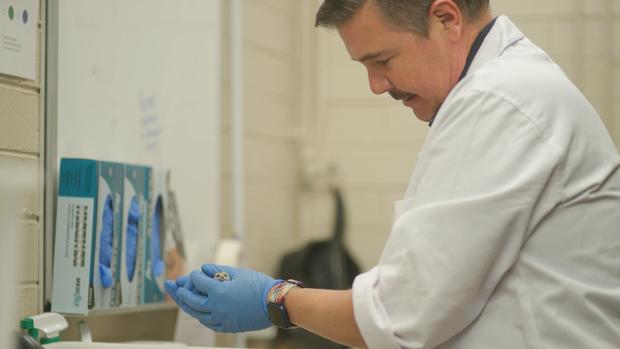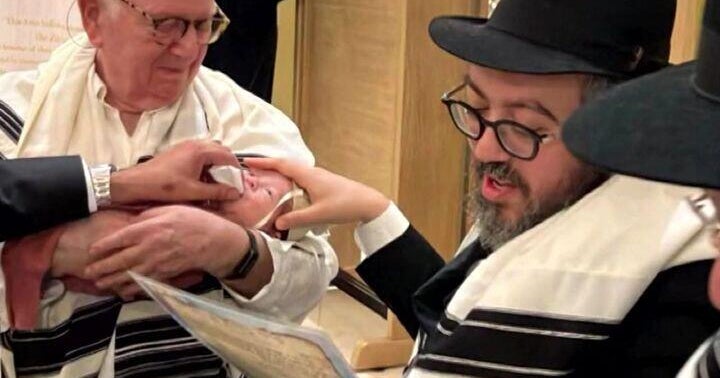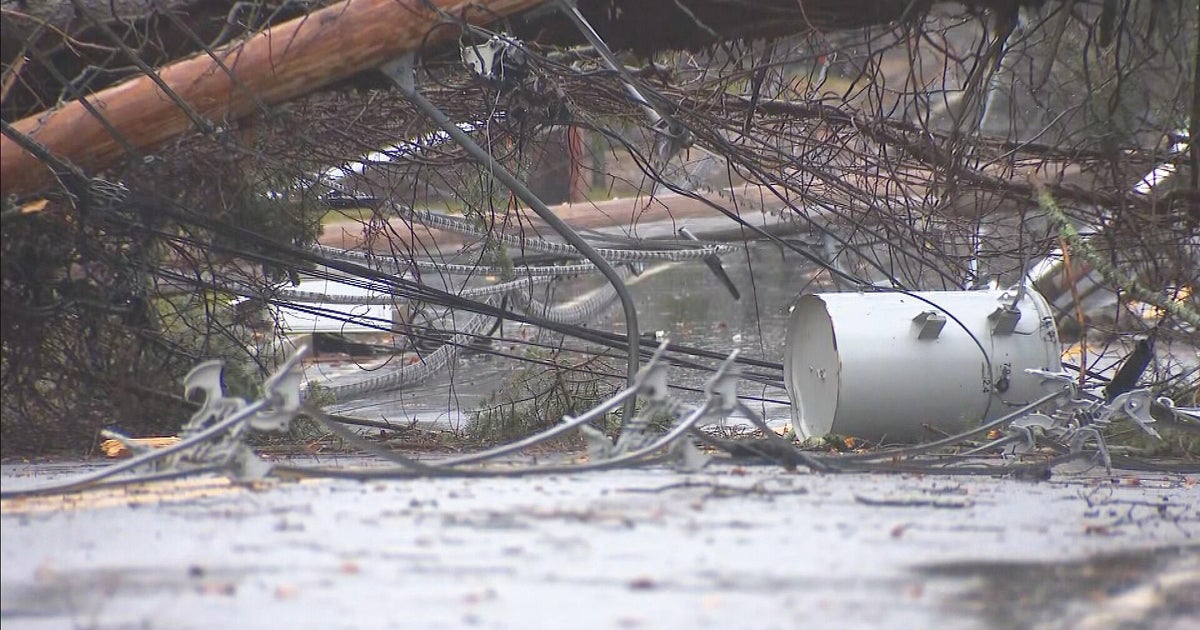Reports of Tasmanian tiger sightings come by the thousands as Aussies search for extinct thylacine
This is an updated version of a story first published on April 14, 2024. The original video can be viewed here.
There's the Loch Ness monster in Scotland. And in the Himalayas, there's the yeti, the Abominable Snowman. In Tasmania—a teardrop of an island under the eye of the Australian mainland—there's the thylacine… a creature, as we first reported last year, that brings out folklore... and folks armed with grainy images, convinced they've seen the thing. But unlike other mythical creatures, the thylacine, or Tasmanian tiger, actually—indisputably— existed, an apex predator the size of a small wolf, roamed the island as recently as last century. which gives hope to so many obsessives, dreamers and true believers, looking for the Tasmanian tiger in the bush… and, as you'll see, in the lab. This is a story that says as much about human nature as it does nature nature. Further proof that—even in the face of science and logic—passion survives in the wild just fine.
Jon Wertheim: You've been doing this how many years now?
Adrian Richardson: I've been doing this for over 30 years, and (beeping) every day's an adventure.
Jon Wertheim: All right, here we go.
Getting there wasn't easy. But Adrian "Richo" Richardson—a retired military man turned self-declared tiger seeker—retraced his steps. tramping around the dense outback of Tasmania on Jan. 28, 2017, 12:45 p.m., he heard the sound…
Adrian Richardson: And then all of a sudden, was this a mighty howl like this. (howls). I was gobsmacked. The hairs on my arm and my neck stood on end. And as that call finished, another one come from the other side of the forestry track. Another howl like that.
Jon Wertheim: What'd that one sound like?
Adrian Richardson: Exactly like.. (howls).
Richo craned his neck but saw no creature. Still, he's sure of what it was: a Tasmanian tiger.
Adrian Richardson: The whole environment went quiet for about a minute. It was an unbelievable feeling. I just can't explain it.
Jon Wertheim: Yeah. You're still emotional talking about this.
Adrian Richardson: Oh, look, I'm going to remember that call until the time I die. And then I had to try and prove to others what I've heard.
When he returned to his home in Hobart, Tasmania's capital, he didn't go down to the pub to share his account. No, he took to his desk and stayed up writing a detailed report, flush with 22 footnotes.
Adrian Richardson: What my passion is. It's the thylacine. I know it's there.
Jon Wertheim: And this only reinforced your faith.
Adrian Richardson: Oh. Without a doubt.
One slight hitch—one crimp on the barbie, as it were—the creature Richo describes so vividly and breathlessly? It was declared extinct almost 40 years ago.
Jon Wertheim: Thought, you know, maybe it's a dingo. May-- maybe it's a wolf.
Adrian Richardson: In Tasmania, we do not have anything remotely like it. We do not even have wild dogs in any form. The only feral things we have around here is deer or cats.
Jon Wertheim: I don't think deers are making that noise you just made.
Adrian Richardson: No, sir. They did not.
The Tasmanian tiger roamed these parts for thousands of years. More wolf than tiger, it was (is?) a marsupial weighing about 55 pounds…
It was also a carnivore… that preyed on farmers' sheep. Recalling the fate of the wolf of the American West around the same time, the local government paid out bounties to hunters presenting carcasses… by the mid 1930s, the Tassie tiger population had dwindled to one … captive at Hobart's Beaumaris Zoo, where it died in 1936…
With the required 50 years elapsing without a confirmed sighting, the tiger was put on the extinct list in 1986… yet—putting the mania in Tasmania—the search became a national obsession… and the Tasmanian tiger —not the Tasmanian devil—became a sort of local mascot. Its image adorns Tasmania's coat of arms and government buildings. Here's the island's current license plate.
At local watering holes, the regulars put down their Tassie tiger beer long enough to tell you they've seen the animal, or know someone who has.
When Nick Mooney was a full-time Hobart biologist, it fell to him to investigate the various Tasmanian tiger accounts. Now in retirement, he's the island's unofficial arbiter.
Nick Mooney: I know several people who've got clusters of cameras in very remote areas serviced remotely by satellite, and who go and check on the cameras with their own helicopter, all sorts of things.
Jon Wertheim: We've moved way beyond the guy with binoculars saying, "I think I may have seen something."
Nick Mooney: Oh, absolutely.
He can't help notice: no one ever quite captures a clear image. Still, reported sightings come by the thousands.
Jon Wertheim: Have you ever gotten a report or ever looked into something that, eh, gave you a little pause?
Nick Mooney: Yes. Sometimes people are dead accurate with the times, the places, the distances. And they're very good naturalists, often don't exaggerate. Like, they take their skills very seriously. And it's very hard to say to those people, "I don't think you saw a thylacine."
For the devoted army of seekers, the investment isn't just one of hope and time. Each year, Richo spends, um, more-than-he-cares-to-admit dollars on trail-cam batteries alone.
Jon Wertheim: How much money have you sunk into this obsession?
Adrian Richardson: Sir, I wouldn't like to speculate. And please don't tell my wife. (laugh)
Jon Wertheim: Make it our secret.
Adrian Richardson: It's our secret. She often asks and I go, "Go and get your hair done, darling." (laughter)
Jon Wertheim: Go shopping. (laugh)
Adrian Richardson: Can I stop that one? Can I stop that one? (laugh) Can we redo that one again? (laughter)
In the bush, we met another enthusiast, Chris Rehberg, who flies down from mainland Australia and approaches the search in the manner of a CSI detective.
Jon Wertheim: Apart from the cameras I gather you've been scouring for prints, fur, even poo?
Chris Rehberg: Yeah, everything. So scats. Footprints is a big one. And I found a series of 18, 19 individual steps in a track line that are an excellent match for Tassie tiger. Not only are they an excellent match, the quality of the prints is pristine. Scats, keep an eye out, check it out. You know, what's the animal been eating.? Yeah, and calls if you hear them.
There are even tracking collectives. Richo was part of the Booth Richardson Tiger Team, which made worldwide news in 2017, after calling a press conference to announce a sighting… but when they provided this image as "proof," Nick Mooney assessed it as a "chance," but not an official confirmation.
Jon Wertheim: What is the middle ground? You can be right, you can be lying, or what?
Nick Mooney: Or you can have an illusion. And there's all sorts of ways that our memory can be affected by time. I have had lots of talks with psychiatrists, and ex-detectives trying to figure out this. You really often have to make a choice, a personal call in the end.
Jon Wertheim: To essentially tell them they're wrong and their mind is deceiving them?
Nick Mooney: You can't tell 'em that, because you don't know. Essentially, if you weren't there, you don't know.
Richo and all the other seekers won't have to wait long—they won't even have to go into the bush—if a group of tech investors and biologists deliver on their goal.
Andrew Pask counts himself among the Tassie-tiger-transfixed. He comes to the quest, though, armed not with binoculars, but a microscope in his TIGRR lab.
Jon Wertheim: Envision that day when you're not just wearing it on a pin.
Andrew Pask: 100%, yeah. 100%. I think about it all the time, what it would be like to be in that landscape and just to see one walking past in the bush, an actual one, rather than a crappy photograph.
Jon Wertheim: Tell us exactly what you're doing.
Andrew Pask: We can't magically bring the Tasmanian tiger back. We have to start with a living cell, and then engineer our thylacine back into existence. So the way you do that is you find the closest living relative to your animal that has gone extinct, and for us that is a small marsupial species called the fat-tailed dunnart.
A developmental biologist at the University of Melbourne, Pask has raised $15 million for a de-extinction project that recalls Jurassic Park….
In partnership with American company Colossal Biosciences, which counts—wait for it— Leonardo DiCaprio, Paris Hilton and even the CIA among its backers.
He's adamant he'll replicate the genome of a dunnart—a mouse-like marsupial—and turn it into a (much larger) Tassie tiger…we'll let him explain.
Andrew Pask: We examine all of its DNA, we compare that to the DNA of your extinct species, the Tasmanian tiger, and we look at everywhere that those two genomes, or those two piles of DNA, if you like, are different. And once you've identified those differences, it's just a matter of then going in and making all of those edits to turn your fat-tailed dunnart genome, or cell, into a thylacine cell.
Jon Wertheim: And you're saying that dunnart—that little field mouse marsupial dunnart—is closer than, say, the Tasmanian devil?
Andrew Pask: But that little dunnart is a ferocious carnivore, even though it's very, very small. And, it's a very good surrogate for us to be able to do all of this editing in.
A native of Minnesota, Kris Helgen was director of the Australian Museum Research Institute in Sydney. He understands the push to de-extinct the Tassie tiger…
Kris Helgen: This is one of my favorite mammals.
Jon Wertheim: Really?
Kris Helgen: And I love all (laugh) mammals. I am a mammal guy. This is a special, special animal.
He took us upstairs to his lab to show us why…
Jon Wertheim: What do you make of this de-extinction effort with respect to the Tasmanian tiger?
Kris Helgen: You know, I would be the first person to line up to see this animal if it could be somehow brought back from extinction.
That said, Helgen is the skeptic, gently explaining that wishing Tassie tigers were running rampant doesn't overcome science.
Kris Helgen: This is an impossible project.
Jon Wertheim: We all love optimism. We all love innovation.
Kris Helgen: What they're saying is, "We're going to modify the genome of a dunnart to create a genetically modified dunnart that might look a bit more like a thylacine. Maybe we'll be able to tweak it genetically and it gets a bit bigger. Maybe we'll be able to tweak it genetically and it has some stripes on it. But there is about 1,001 steps in between.
Helgen has thought about the source of the current Tassie tiger passion… and wonders how much of it is driven by remorse.
Kris Helgen: It's a special symbol about Australia and about what we've lost. We've had a lot of extinctions here. In the last 100, 200 years, 30 mammals alone. So in the United States, only one or two mammal species have disappeared entirely.
Jon Wertheim: So why are people taking this seriously? And why are people investing so much in this?
Kris Helgen: So many people have the dream, "If we could just get this animal back." Maybe, it would help us think different about extinction or the guilt that we might feel of having removed such a special animal from the planet. Whether, you know, they imagined it might be still hiding in Tasmania or in a lab to be reborn, there's this burning hope.
Richo reckons that if his countrymen in the DNA sequencing labs can resurrect a Tassie tiger, good on' em… but, regardless, he'll continue coming here… faith unshaken, he's certain this animal most famous for being extinct, is not extinct at all.
Jon Wertheim: If someone accused you of being obsessed, would you plead guilty?
Adrian Richardson: Oh, sir. I put my hand up to that. Your Honor, I am guilty.
Jon Wertheim: You're Tasmanian tiger obsessive.
Adrian Richardson: I am, indeed. It's been my love.
Jon Wertheim: Why is that? I mean why have you continued to search so-so long for this?
Adrian Richardson: I just know it's there. I do. In my own heart, I know it's there.
And if it isn't there? Well, we say what's the harm in searching? Coming to the planet's sub-basement, bush-bashing this gorgeous terrain? There are worse ways—and places—to spend your days.
Produced by Jacqueline Williams. Associate producer, Elizabeth Germino. Edited by Patrick Lee.











